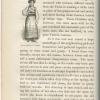Drawing of a woman
Drawing in ink by Arthur Evans of a young woman with plaited hair, identified as a portrait of a Catholic inhabitant of Tešanj, Bosnia and Herzegovina.
Artist: Arthur John Evans
Date of drawing: August 1875
Continent: Europe
Geographical area: Southern Europe
Country: Bosnia and Herzegovina
Region/Place: Tešanj
Cultural group: European Bosnian
Format: Drawing
Size: 71 x 27 mm; 117 x 73 mm (with mount)
Acquisition: Joan Evans. Donated August 1941
***
Exhibition caption: ‘One of a selection of drawings and ink sketches made by Arthur Evans while travelling with his brother through Bosnia and Herzegovina in the summer of 1875. They show people and places encountered by the pair on a route south from Agram (modern-day Zagreb) – via Tešanj, Sarajevo and Mostar – to Ragusa (Dubrovnik), which Evans and his wife were later to make their home. The illustrations demonstrate a particular interest in identity and dress, Evans writing, for example, of finding “two Bulgarians hard at work tying up bundles of onions, clad in their dark national costume – the brown tight-sleeved jacket embroidered with black, the dull red sash, the brown trowser-leggings which are equally Turkish and Tartar and on their head the black sheepskin cap which had at first attracted my attention.” As well as being an aide-mémoire, the drawings provided the basis for engravings published in Evans’ account of his journey, Through Bosnia and the Herzegóvina on Foot during the Insurrection, August and September 1875 (London, 1876). As an eyewitness account of a distant region in turmoil, the book was an immediate success, quoted extensively in Parliament, and it went into a second edition the following year.’ Source: ‘Travels in Finland and Bosnia-Herzegovina: An Ethnographic Collection of Sir Arthur Evans’, exhibition curated by Philip Grover, Pitt Rivers Museum, University of Oxford, 29 April to 1 September 2013.
Primary documentation: ‘[p.588] Dr. JOAN EVANS, from the property of the late SIR ARTHUR EVANS, Youlbury, Boars Hill, Oxford. [List of items follows]’; ‘[p.590] 21 Original pencil sketches, types & scenery. BALKANS’: Pitt Rivers Museum accession records (Donations X, 1937–1941), pp.588, 590.
Research notes: It has been identified by Philip Grover that this original drawing was used as the artwork for a woodcut engraving subsequently published in Arthur J. Evans, Through Bosnia and the Herzegóvina on Foot during the Insurrection, August and September 1875 (London, 1876), p.120, printed with the caption ‘Latin Maiden of Tešanj’. Evans recorded in the volume: ‘While trying to make my way to the other side of the valley I found myself hemmed in by a variety of fences, which I was forced to surmount, and run the gauntlet though private orchards, with whose owners I happily avoided an encounter, and finally emerged with a whole skin on the Christian quarter, which lies east of the castle. The inhabitants here belonged to the Latin Church; but though the Roman Catholic priesthood in Bosnia leans toward Croatia, and shrinks from Serbia with more horror than from Stamboul, yet these Latin women of Tešanj betrayed, perhaps unconsciously, their sisterhood with the heretics of Drina. They were not coiffed Croat fashion, in a kerchief, like the peasants we had seen in the Bosnian Possavina, but their hair was plaited round a fez, à la belle Serbe, with flowers stuck in coquettishly on one side, and drooping gracefully about the ear. They displayed, too, the Serbian partiality for purple, and a maiden with a scarf crossed over the bosom recalled the peasant girls around Belgrade. The rest of their dress - the double girdle, the twin aprons, the tunics with expanding sleeves - may be described as South Sclavonic. The men, though surmounted with turbans, differed usually in place of the gorgeous vest and jacket, and short flowing white trowsers instead of indigo bags. Those Christian men, however, who were more well to do, and inhabited the mercantile part of the town, were, like our landlord, in complete Turkish costume’: Through Bosnia and the Herzegóvina on Foot, pp.119–120.

